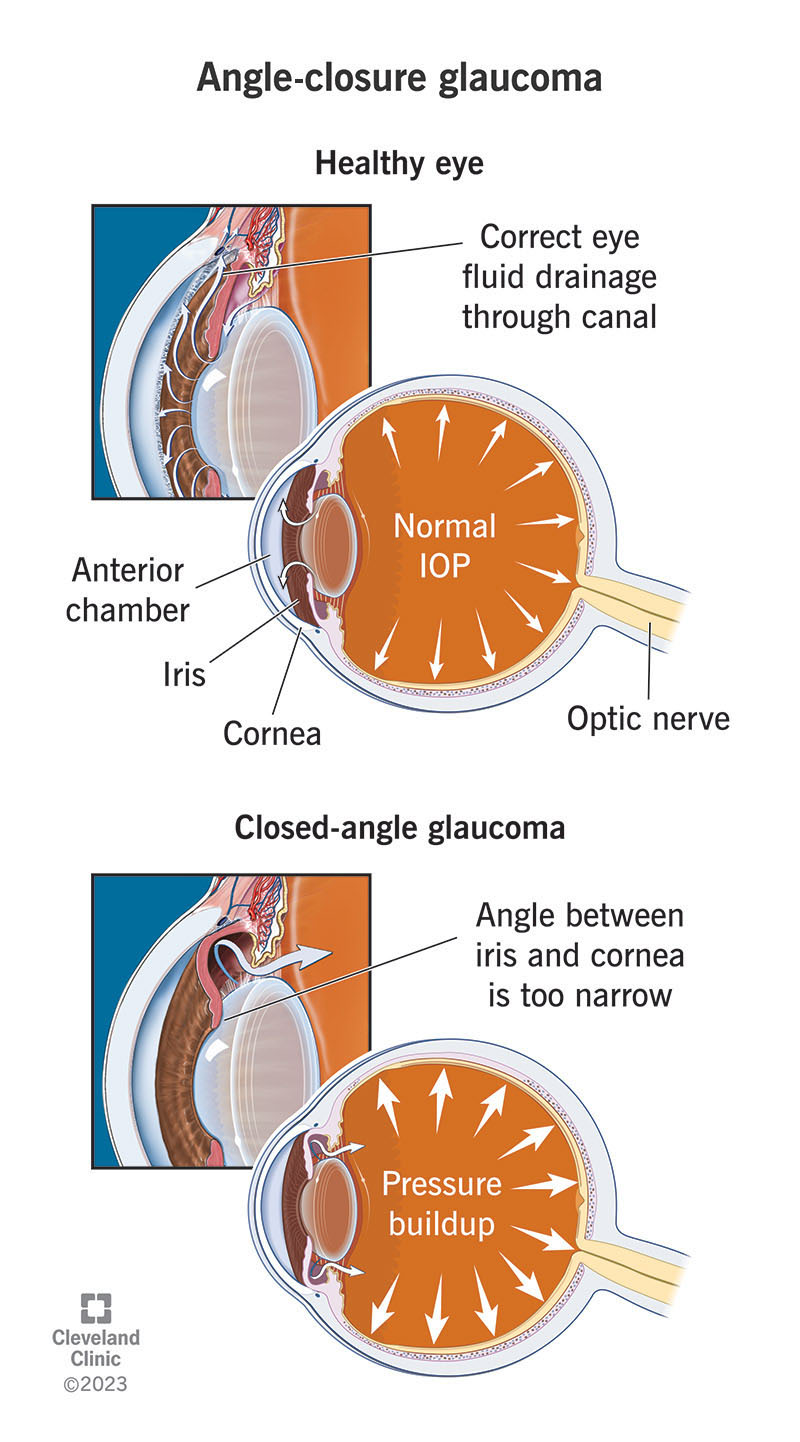Angle-closure glaucoma happens because your enlarged iris blocks fluid from draining properly in your eye. This causes your intraocular pressure to rise. Acute (sudden-onset) angle-closure glaucoma causes eye pain, red eye and nausea. You need help immediately for this medical emergency.
Advertisement
Cleveland Clinic is a non-profit academic medical center. Advertising on our site helps support our mission. We do not endorse non-Cleveland Clinic products or services. Policy

Angle-closure glaucoma is one of two main types of glaucoma, a condition that’s defined by high pressure within your eye. The name for this pressure is intraocular pressure (IOP).
Advertisement
Cleveland Clinic is a non-profit academic medical center. Advertising on our site helps support our mission. We do not endorse non-Cleveland Clinic products or services. Policy
High IOP happens because fluid called aqueous humor can’t flow freely in your eye. In angle-closure glaucoma, a bulging or swollen iris (the colored part of your eye) blocks the drainage system. The condition may happen quickly or over time.
Other names for angle-closure glaucoma are closed-angle glaucoma and narrow-angle glaucoma.
There are different types of angle-closure glaucoma, including primary and secondary forms.
Primary angle-closure glaucoma
Secondary angle-closure glaucoma
This form happens along with another condition. These include:
Advertisement
Angle-closure glaucoma will happen to about 1 in 1,000 people. It’s most likely to happen after the age of 40.
One estimate is that 17.14 million people throughout the world who are over 40 have primary angle-closure glaucoma, with a majority (12.3 million people) in Asia.
Acute angle-closure glaucoma symptoms may include:
When they’re present, which doesn’t always happen, symptoms of chronic angle-closure glaucoma and other forms of non-acute angle-closure glaucoma may include:
Angle-closure glaucoma happens because aqueous humor in your eye can’t flow in and out as it normally should. Your body constantly makes new fluid to replace the existing fluid.
When the old fluid can’t leave your eye, it backs up and causes pressure. The pressure causes damage to your optic nerve.
There are many reasons that you can get glaucoma. With angle-closure glaucoma, the reason is that your natural lens thickens over time and pushes against your iris, blocking the drainage passages.
Research indicates that angle-closure glaucoma has an association with family history and certain genes.
Risk factors for developing angle-closure glaucoma include:
Like other forms of glaucoma, angle-closure glaucoma can damage your optic nerve and cause permanent loss of vision.
Any medical examination begins with your provider asking you questions about your symptoms and medical history, including information on your biological family’s history.
Your eye care provider will give you a thorough eye exam.
Your provider will diagnose angle-closure glaucoma using:
If your provider thinks you have angle-closure glaucoma, they’ll avoid using drugs that dilate your pupils because those medications could make drainage worse.
There’s no cure for angle-closure glaucoma, but there are treatments.
Treatment for acute angle-closure glaucoma must happen quickly to avoid vision loss.
Advertisement
Your provider will offer treatments that may include:
Your provider is likely to treat non-acute forms of angle-closure glaucoma with laser iridotomy.
Your provider may also suggest cataract removal, which should make the progression of chronic angle-closure glaucoma go more slowly.
Complications may include blurred vision and sensitivity to light for a few days. You may also experience a streak of light from the site of the laser treatment. You typically need a driver to take you home after the procedure, but you may start normal activities the next day.
If you have treatment for angle-closure glaucoma, your outlook should be good. If you have acute angle-closure glaucoma, you need immediate treatment to preserve your vision.
You should listen to your provider’s suggestions on when and how often to return for eye exams.
Advertisement
No, you can’t prevent angle-closure glaucoma. But screening eye exams with an eye care provider will help you know if you have risks for angle closure glaucoma. They’ll then suggest treatment and medications to avoid if you’re at risk. It’s also very important to manage your blood sugar if you have diabetes.
You should always see an eye care provider if you have changes in your vision. Follow the appointment schedule they suggest for you.
Times when you should get emergency medical help, like calling your eye care provider or going to an ER, include these events:
You may want to ask your healthcare team these questions:
Advertisement
It can help to take notes during your appointments. You may also want to bring a family member or friend to help you remember questions and answers.
Glaucoma is common, and there are many types. Angle-closure glaucoma is one of these types. If you have an episode of acute angle-closure glaucoma, treat it as a medical emergency.
If you have eye pain, headaches, redness and you feel sick to your stomach, contact your provider or go to an emergency room. You may need immediate medical treatment to save your vision. Other types of angle-closure glaucoma also need treatment. It’s best to find out what you have and how to treat it early on in any condition.
Last reviewed on 09/17/2023.
Learn more about the Health Library and our editorial process.